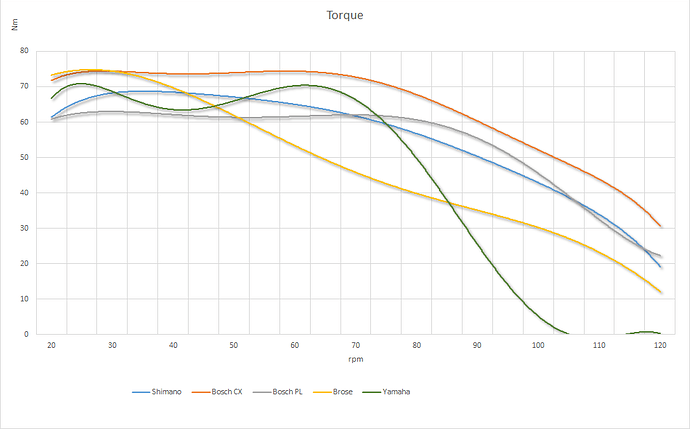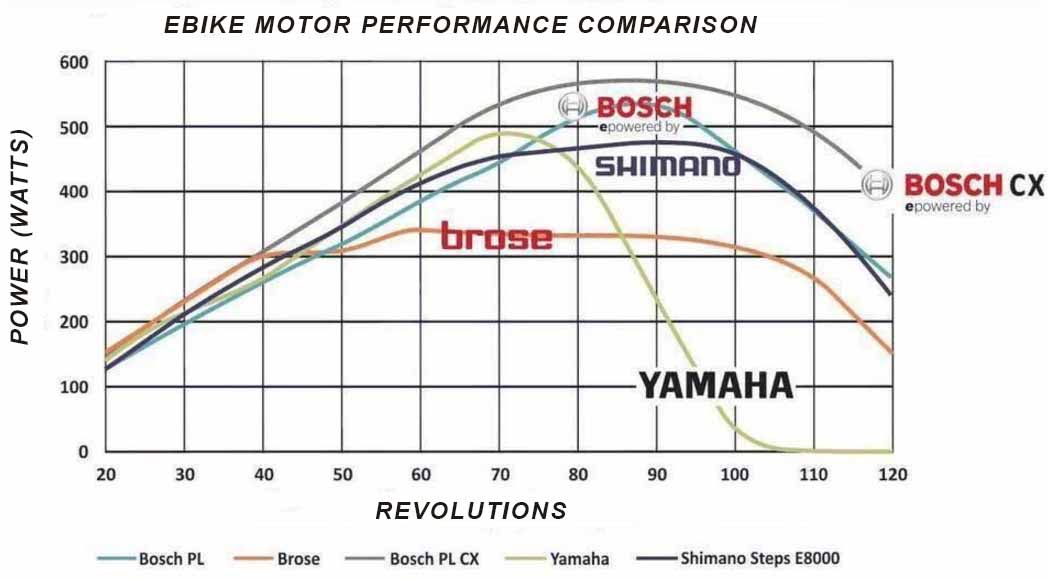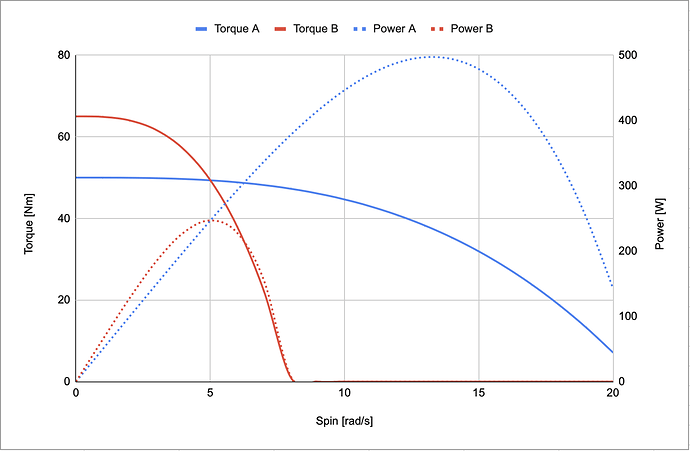yes. for instance there are 25 km/h ebike with traditional rim brakes, but if you take away the limits, and want to go faster, then you do need disc brakes.
I was more focussing on the power train part but yes, basically thats it.
Side note : always wondering how it can be that the brakes on e-bikes look like regular cycle brakes. With the extra weight and speed it should actually lead to bigger break systems… or higher wear and tear.
Regular bikes can and very often do go faster than pedal-assisted e-bikes, and the weight difference of pedal vs e-bikes (let’s say 10 kg?) is not very large compared to the possible weight difference among users.
In most situations decent rim brakes would be more than enough for slowing you down, what limits braking performance is usually the traction of the tires, if not the skills of the driver.
That said disc brakes are easier to modulate and are much more consistent in the wet/dirt so for commuters they are probably a no-brainer.
A couple of considerations
- The instant acceleration from a stop is also very dependent on the software control of the power unit, they all smooth it out because it would be dangerous to instantly put out 100% pedal assist at the first hint of a pedal stroke. Different motors can deliver the initial assistance in very different ways, independently of the max declared torque values. The best is to do a test drive.
- The speed on the climbs is usually dependent by the power output: 250W are more than enough to hit 25km/h on flat terrain but they quickly become the limiting factor as soon as you get on a moderate incline
But are you sure that torque isn’t what really decides? If we have two 250 W ebikes, but one has 40 Nm and the other has 65 Nm, will they both perform the same uphill? Torque is a force applied at an angle, as if you were pulling a wrench attached to a nut.
I thought that what makes the engine have high power is the ability to spin fast. So if we take two different engines:
65 Nm * 4 Hz = 260 W
50 Nm * 10 Hz = 500 W
Then it has to mean that the first engine delivers its maximum torque at 4 Hz and the second one at 10 Hz?
So I guess we would have to see the full torque curve to know, but I think electric motors, unlike ice, deliver full torque for the entire range of rpm?
OK I found some charts.
So yeah, it looks like a high-torque, low power engine will give you an advantage at low rotations, but the torque will drop at higher rotations. Whereas a high power + low torque motor will be slow at the start but will maintain the torque up to high rotations.
But of course there’s also the transmission to consider.
Exactly…it’s important to downshift on the climbs (like you would on a regular bike), the ebike motors are built to deliver max power approximately in the same range of rpm that the human body does (we’re talking 1-2 Hz, if you can pedal at 4Hz you’re not human ![]() ).
).
Torque can become a limiting factor if you’re hitting very steep climbs at low rpm. But even on a 5% incline you already need much more than 250W to go at 25 km/h, so assuming you’re downshifting properly the climbing speed is probably limited by the power output.
This is not the correct formula, the rotational speed needs to be in rad/s instead of Hz. 4Hz=25 rad/s so in your example you’d get 1625W…but again 4Hz is impossible to sustain on a bike
Yeah, the charts I found go up to 120 RPM, which is 2 Hz.
I went once up a hill, 1 km height difference over the distance of 10 km. That’s 10% average incline. I was going at 10-15 km/h and of course using the lowest gear. A speed lower than 10 km/h was not possible, as it would become too difficult to pedal. I could put my whole weight and still I would not have enough force. So I think my bike’s transmission just doesn’t go low enough to allow going up very steep.
But again, power is just an outcome, no? It’s the maximum energy conversion rate that is reached at the best combination of torque * rpm. If you were free to change the “gearbox”, you could make a high-torque low-power engine reach higher power by changing the transmission, or?
You just blew my mind. I totally got it wrong! I thought Hertz is the correct unit to use. But no, the unit of angular velocity is radian per second.
Google somehow can’t convert it to watts when I provide radians or revolutions. So the correct formula is:
65 Nm * 4 rad/s = 260 W
50 Nm * 10 rad/s = 500 W
or:
65 Nm * 38 rpm = 260 W
50 Nm * 95 rpm = 500 W
Nope…the max power output is defined by the motor (the nice graphs you posted above) and is tipically reached at a very specific crank arm speed. The gearbox doesn’t increase your max power, but it crucially allows you to access it at different wheel speeds, allowing the crank arm to turn at the optimal rpm regardless if the wheels are turning very slow (like on a steep climb), or much faster (downhill)
That said it really sounds like your trasmission is not going low enough for a 10% hill(which is fairly steep tbh).
The good news is that on bikes its actually quite easy to change the gear ratios to a certain extent. If you do these climbs often you can ask your bike shop to install larger sprockets or smaller chainrings next time you wear them out (they should cost pretty much the same regardless of their size). You will be losing some top speed on the downhills but that’s probably not a big deal.
Ah, I think I get it now!
OK, so the gearbox does not change the power, but it changes the torque at the wheel, correct?
So let’s take these two bikes from Landi:
*A: 65 Nm, 250 W
*B: 50 Nm, 500 W
In order for bike A to have higher torque at the crank, but lower power, it has to have higher friction/heat losses, which prevent it from reaching high rotation speed?
But in that case, we can see that in the 0-5 rad/s range bike A delivers more power, so it should accelerate faster at low speeds. Does it make sense?
My GF bought the Xiaomi Essential for 320 CHF. Advertised with 20km range and 20kmh speed.
With 102kg in BW it’s definetly not a good choice. Got 5km in usable range (at ~50% battery level) with decent speed (10-11kmh with 5-8% incline, 4-5km with 10-12% incline though) and after that you start feeling how it gets slow. It got me barely home after the battery level dropped below 30%.
It was still fun to drive. I guess with 60-70kg in BW you’ll be able to get 7-10km in usable range with decent speed. So it will work for my GF.
But for me? VX2 ST it is.
So my GF tested it out today. 11.1km with 31% battery left and pretty constant speed. Good enough for her. I got 8.6km with 3% battery left and the last 2km sucked ![]()
Get two, one for each foot. ![]()
I was thinking for while to get one of those Chinese bicycle upgrade kits (e.g. this one). But I’m still hesitant, not sure what the reliability & legality of these kits are. It would be a more frugal choice I suppose, but I fear there is a high chance of regretting that purchase.
SportXX has special offers today.
I just ordered the VX2 ST for 719 instead of 899 ![]()
Hello guys, I would like to start trying a road bicycle and I have been seeing that Decathlon , as always, is having very competitive prices in the market. I am truly a beginner, so I do not need anything super-profi, yet I would like to get something comfortable enough to appreciate riding it and not getting depressed after few times. This , I believe, is in at the biggest risk I may face.
I saw that there are cheap models (gravel and /or basic road bikes) that I would exclude, mainly because of weight and lack of proper speed selector (only 8 in the back, making complex , for example, going to the mountains).
I saw the triban 120 and the triban 520. They look both extremely interesting. 520 a bit more even for few franca more.
Anyone having any experience with his specific models or, more in general, with Decathlon 's bicycles?
On the other hand, I saw gonser.ch is proposing road bicycles for around 250-300 chf, so half price respect to decathlon. Even thaw they look like to have all 5 stars, when reading in details the customers’ feedbacks, it seems they are pretty bad quality.
Anyone having tried them?
Last but not least, is there other suggestion in the 500-1000 chf price range (bicycle+pedals+shoes)?
I’ve never used Decathlon bikes, but many of their other products and all seem to be very good value for money while not being trash, so I’d expect their bikes to be similar.
In the end, road bikes are very simple machines so you have very quickly diminishing returns as you climb the exponential price curve.
There’s plenty of people who will pay for a couple of grams shaved off here or there, but it is the same in many hobbies when people get fixated on equipment instead of the actual hobby.
For most people, spending more time training and losing kg on the body would be a better investment!
The RC120 looks great value on sale now for a few days more at 439 Fr.!
You could also look at specialist firms such as Canyon who make reasonbly priced carbon bikes. Of course, you can get great deals 2nd hand from people who spent a fortune on a fancy bike and then ended up hardly riding it!
Congratulations on deciding to take up this sport which is a great way to enjoy our beautiful countryside
The components on the triban 520 seem to be Shimano 105 which is very good.
I agree with Phil about people wasting fortunes optimising weight. As you mention mountains, both bikes are >10.8 kg, which is really heavy for for a road bike. If you are taking it up as a pastime I would suggest to invest in something at least 1.5 or 2kg lighter if you can afford it
Maybe you could rent a bike and climb a mountain before deciding. You will get an appreciation about weight and gravity very quickly
Triban 520 review (from flat UK - not Switzerland)
Obviously the 520 is a much nicer bike and also discounted to 770Fr.
I tried to find a cheap Canyon and saw this but already €1300:
Carbon equivalent €1900.
Wow. Bikes got a lot more expensive than what I remember from when I last looked 7 years ago. Maybe it is the covid effect?
My memory is hazy, but I thought I paid around €799 for my carbon Canyon after being too cheap to step up to the next model up at €1299.
Its true, cycling gear had a large price increase over the years. The scarsity during covid drove everything way more expensive and prices remained after customer demaned waned.
Four things drive a bikes price (assuming new)
- brand and model. Your percieved quality
- drive components - groupset - shifters, chainring, cassette, crank, etc. Weight, performance, quality of life like double downshift, e-shifting, wireless, feel of shifters and placement, number of gears front/back, 1x11/12 or 2x9-12.
- frame incl fork - carbon, what carbon, steel, alu. Shape and comfort.
- Secondary components - wheels, saddle and post, handlebars, brackets etc This is where they skimp on most and hide details in specs, if available at all.
- (e-bike stuff is fifth, but not applicable)
Dont get caught up in chasing the components game, there’s a reason road cycling is so strong with 40-60yo men with above average income as you can spend too much money for no real benefit. When comparing, you typically compare the main elements like frame construction and drive components. The savings are often hidden in more details, they state a 105 groupset but that’s really just shifters/levers, derauler and the rest like brakes and chainring is from 1-2 series worse series. Recommend to read a little about differences between groupsets and what they bring - practically only road/offroad shimano/sram, ignoring the top 2 completely.
The best thing to do, is really try the bike physically. The ergnomics must fit you and be adaptable to you. Sizing is hugely imporant. Little details like crank lenght can be adjusted at a shop. Saddle might be terrible (usually is) and you can swap to something better etc. And secondaly, you must like the color, also something you notice in person better. A pretty bike (to you) with worse specs is better than that better on paper, if you dont get the emotional attachment to it. Decathlon bikes are solid for their price and good tiers. Similarly the B2C etailer like (edited) Canyon are good value for money, have three in family myself. Can recommend the Endurace if road and Roadlite if flatbar hybrid, but might be pushing the budget. Remember bikes mostly dont come with pedals. Might see more sales in coming weeks, clearing last years models.
Depending you expectation and budget, you do not need to buy a new one at the beginning.
I ride an hopeRider decathlon bike since 2020, I’ve bought second hand for half the price you mentioned.
You may also find good deal in a local association that recycle and repair bikes. It has the benefit to free the road and parking from dismantles bikes and reduce the carbon impact from making a new bike.
In Geneva, you could visit la Fourrière a velo near Bouchet.
They provide decent service and have a wide offer depending on arrival.



